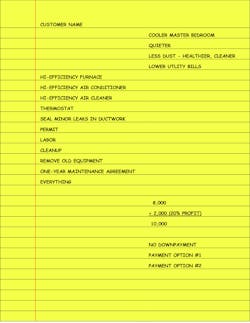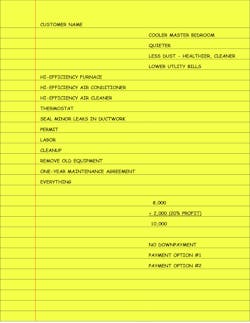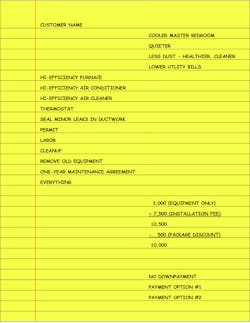Two Unusual HVAC Closes That Work
Lots of people want at least a ballpark price on a replacement job over the phone before they’ll even make an appointment, while others may interrogate you at the front door for ballpark price before they’ll let you inside to take a look around.
The ‘Permission to Make a Profit Close’
One of the things I’d say to customers like that is, “I’ll give you the price as soon as I know what I’m going to do for you. I’m not going to give you a big long song and dance. I work a little differently than most contractors. I’m going to show you my total cost to do the installation, then I’m going to ask your permission to make a 20% net profit on the job. Is that too much to ask? I have no memory of anyone ever telling me that was too much to ask.
The (Modified) Paper Towel Close
I format the Paper Towel Close a little differently. (See Figure 1.)
FIGURE 1
The top part of it is the same as always. When it comes to writing down the prices, I work backwards. I determine the total price of the job and deduct 20% from it. I then take the remainder, which is 80%, and I write “Total Cost” next to it. I add the 20% below it and label it “20% Profit”. Draw a line under those numbers, add them up, and you’ve got your total price.
The Close
When it came time to present the price, I’d pull out the Paper Towel Close, and they’d look right at the price.
I’d say, “Regarding my 20% profit, can we both agree that my cost to do this installation for you far exceeds the direct cost of the furnace and air conditioner, and the hourly wages of the installers?” I’d get a, “yes.”
I’d go on to say, “I do everything in my power to keep my business expenses to a minimum to keep my prices down, so the way that I arrive at my total cost to do the job is to calculate the exact amount that I pay for the equipment and materials, and the exact wages I expect to pay my installers. Then I take all my other costs of doing business, and I divide them by the number of billable hours that I do per year. That gives me an hourly factor that I can tack onto each job, then I know my expenses for the year are covered and I can still be here to provide you with service after the sale. So, when I show you the total cost to do this job, all of that is figured in.”
I point to the 20%, and say, “There’s what I hope to make on the job, and I almost never hit it, but that’s okay.
“So there’s your bottom line, and I even went ahead and put down a couple of different payment amounts, and you can get it all with no down payment. Does that seem fair to you?”
The ‘Installation Fee Close’
Use this close when you encounter people who have shopped online with the intention of buying their own equipment and having you install it, or when you’re asked, “How much is the equipment alone?” or “How much is just the installation?” or “What are you charging me for labor?”
Like the “Permission to Make a Profit Close”, the Paper Towel Close for this technique is slightly modified in the area where you put the price. Do a little research and go online and see what the online price is for the equipment you’ll be
installing (or a similar model).
Determine the total amount you’ll want for the job, and deduct the retail over-the-counter price of the equipment. The remainder of the total price is your installation fee.
Now — and this is important — add a few hundred dollars to that installation fee. That would be your fee to install customer-supplied equipment.
In the area where you’ll put the prices on your Paper Towel Close, put the price of the equipment on top and the installation fee below it. Draw a line under them and strike a subtotal.
Below that, subtract whatever amount you added on to the installation fee, call it the “Package Discount”, draw a line under it, and strike a final total. (See Figure 2.)
FIGURE 2
Talking Past the Price
“This is the total amount for the equipment alone, dropped off at the end of your driveway. The only thing is, you have to understand, the manufacturer will cover the warranty, and when you install it yourself, or hire someone else to do it for you, neither they nor I, can guarantee the workmanship, the labor, your comfort, or your ultimate satisfaction.
“When I install it for you, you get, my comfort guarantee, my satisfaction guarantee, my guarantee on the workmanship, my follow-up service, and I do all the warranty work, if there is any.
“So, did you want me to install it for you, or did you just want to go ahead and install it yourself?”
Note: I’m not advocating selling equipment over-the-counter to your customers. Your distributor may not even allow you to do so. But people are always asking you to break it down for them, and this is how you do that. No one ever decided to just buy the equipment from me. If they truly just wanted to buy the equipment themselves, you wouldn’t be there in the first place, and your price for the equipment alone wouldn’t be the lowest, so they’ll just buy it from someone else. But with this technique, you no longer have to dodge the request to break down your price.
Charlie Greer is an award-winning salesman and sales trainer, and the creator of the audio book “Slacker’s Guide to HVAC Sales”. For more information on Charlie’s products and services, go to www.hvacprofitboosters.com or call 1-800-963-HVAC (4822). Email your sales questions to [email protected].


